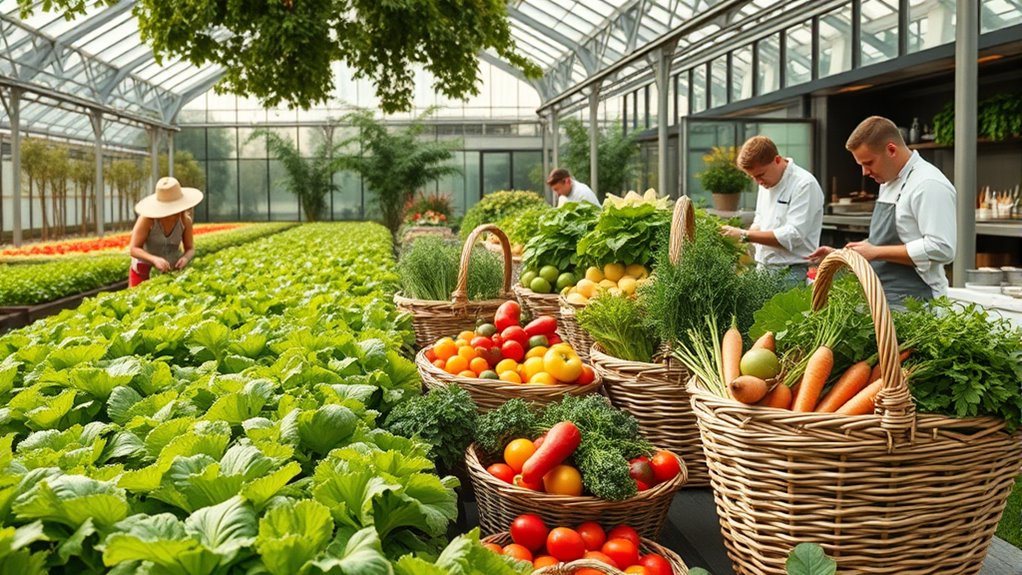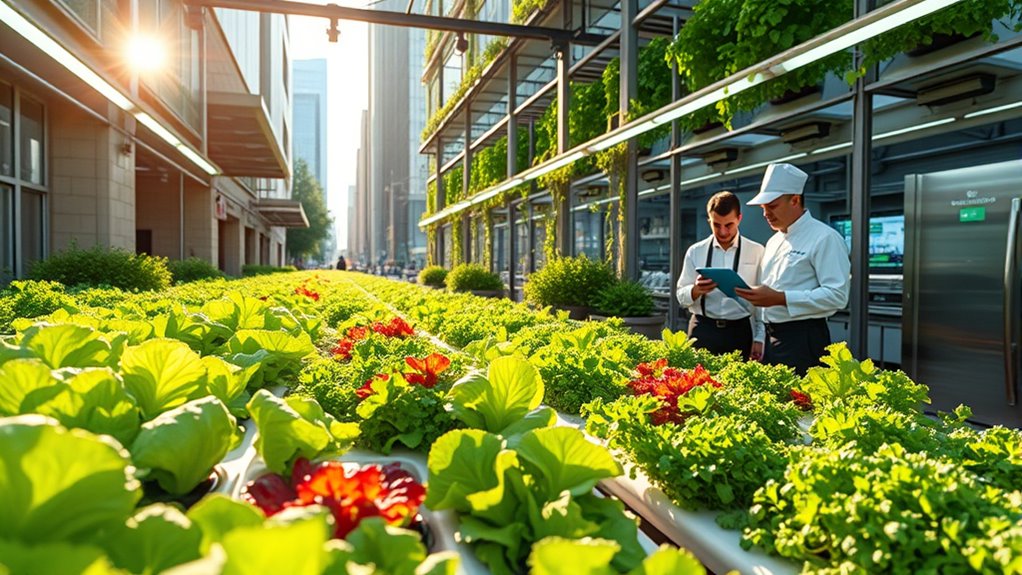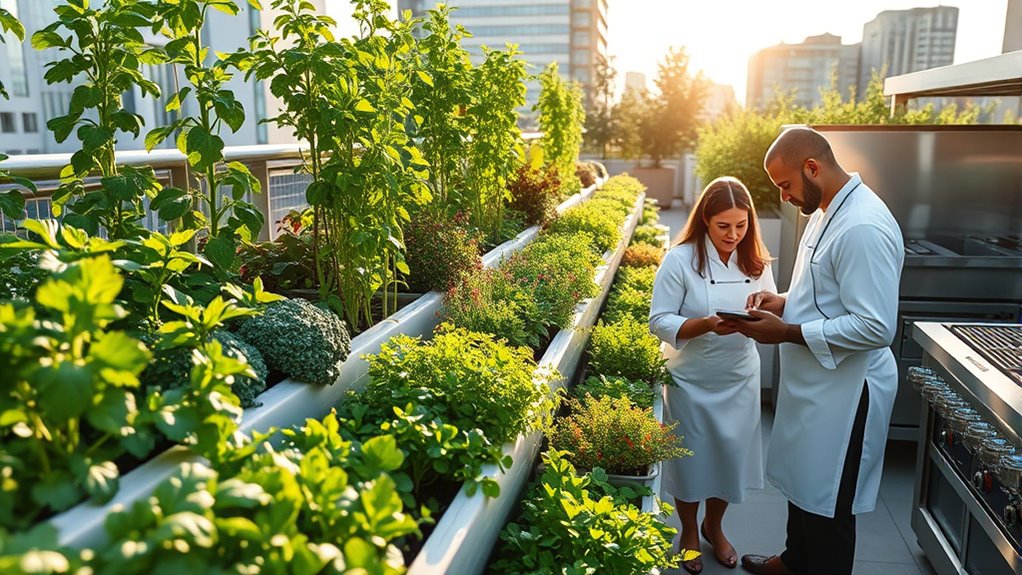Agri‑tech collaborations with restaurants connect chefs directly with local farms through digital platforms, streamlining sourcing of fresh, seasonal ingredients. These partnerships foster transparency, reduce waste, and support sustainable practices like vertical farming and IoT monitoring. Farmers benefit from better crop management, while restaurants get consistent, high-quality supplies. As these innovations grow, you’ll discover more about how technology is reshaping food sourcing and dining experiences for a greener, more efficient future.
Key Takeaways
- Digital marketplaces connect restaurants with local farms, streamlining sourcing and reducing transit times for fresh ingredients.
- Agri-tech tools provide real-time crop data, enabling restaurants to plan menus based on seasonal, locally available produce.
- Sensors and IoT devices optimize farm operations, ensuring consistent high-quality ingredients for restaurant supply chains.
- Sustainable practices like vertical farming and renewable energy adoption improve ingredient quality and reduce environmental impact.
- Data analytics and blockchain enhance transparency, traceability, and trust between farms and restaurant partners.
The Rise of Farm-to-Table Movements and Consumer Demand

As consumers become more conscious of where their food comes from, the farm-to-table movement has gained significant momentum. You now seek fresh, locally sourced ingredients, valuing transparency about how your food is produced. Restaurants responding to this demand prioritize partnerships with nearby farms, reducing their carbon footprint and supporting local economies. This shift isn’t just about freshness; it’s about ethical choices and quality assurance. You’re willing to pay a premium for dishes made from ingredients you trust. As a result, chefs are increasingly designing menus around seasonal produce, fostering a closer connection between consumers and producers. This movement reflects a broader desire for sustainability, transparency, and healthier eating options, reshaping how both restaurants and consumers approach food. Local sourcing has become a key aspect of this trend, emphasizing the importance of sustainable and direct relationships between producers and eateries.
Key Technologies Driving Collaboration Between Agriculture and Restaurants

Farm-to-table platforms and supply chain innovations are transforming how agriculture and restaurants work together. These technologies make it easier to connect, share data, and guarantee fresh, local ingredients reach your customers quickly. Exploring these tools reveals how they streamline operations and strengthen your supply partnerships. Incorporating Self Watering Plant Pots into restaurant gardens can enhance sustainability and reduce water usage for on-site herb and vegetable cultivation.
Farm-to-Table Platforms
Have you ever wondered how restaurants quickly access fresh, locally sourced ingredients? Farm-to-table platforms make this possible by connecting chefs directly with nearby farms through digital marketplaces. These platforms streamline ordering, reduce transit time, and guarantee freshness. They also foster transparency, allowing you to see exactly where your ingredients come from. Incorporating real-time inventory updates helps chefs make quick, informed decisions about their sourcing.
Key benefits include:
- Real-time inventory updates for quick decisions
- Direct communication with farmers for tailored orders
- Data-driven insights to optimize sourcing and reduce waste
Supply Chain Innovations
Advanced supply chain technologies are transforming how agriculture and restaurants collaborate, making the process more efficient and transparent. You now have access to real-time data, which improves inventory management and reduces waste. Blockchain ensures traceability, allowing you to verify the origin of ingredients instantly. IoT sensors monitor conditions during transit, maintaining freshness and quality. These innovations streamline communication, shorten delivery times, and foster trust between growers and chefs. Incorporating expert voice actors into educational content about these technologies can also enhance understanding and engagement.
Benefits for Farmers and Restaurateurs in Agri‑Tech Partnerships

Agri-tech partnerships offer significant advantages for both farmers and restaurateurs by improving efficiency and guaranteeing higher quality produce. With these collaborations, you gain real-time data on crop health, enabling better decision-making and reducing waste. Farmers can optimize irrigation, fertilization, and pest control, leading to lower costs and increased yields. Restaurateurs benefit from fresh, consistent ingredients that meet quality standards, boosting customer satisfaction. These partnerships also foster better communication, allowing you to adapt quickly to market demands. Incorporating trusted custodians for secure data management enhances the safety and compliance of your operations.
Sustainable Practices Enabled by Agri‑Tech Innovations

By integrating innovative technologies, farms can adopt more sustainable practices that reduce environmental impact and conserve resources. Precision agriculture tools, like sensors and GPS mapping, allow you to optimize water use, minimize chemical runoff, and improve crop yields. Vertical farming and controlled environment agriculture reduce land use and energy consumption. Renewable energy sources such as solar panels power farm operations, decreasing reliance on fossil fuels. Additionally, data analytics help identify inefficiencies, guiding better resource management. The table below illustrates key sustainable practices enabled by agri-tech:
| Practice | Technology Used | Environmental Benefit |
|---|---|---|
| Water conservation | IoT sensors, drip irrigation | Reduces water waste |
| Reduced chemical use | Precision spraying | Lowers chemical runoff |
| Energy efficiency | Solar power, LED lighting | Cuts carbon emissions |
Furthermore, adopting sustainable practices can enhance farm resilience against climate change impacts and meet consumer demand for eco-friendly products.
Challenges and Opportunities in Implementing Agri‑Tech Solutions

Implementing innovative agricultural technologies offers significant advantages for farms and restaurants alike, but it also presents a range of challenges. You might face high upfront costs, which can deter investment. Resistance from staff or stakeholders unfamiliar with new tech can slow adoption. Additionally, integrating these solutions into existing operations requires time and adaptability. In some cases, proper training and education are necessary to ensure smooth implementation and effective use of new systems.
However, opportunities abound if you navigate these hurdles wisely. You can improve supply chain transparency, reduce waste, and enhance product quality. Embracing tech also allows you to build stronger relationships with consumers who value sustainability. Recognizing these challenges helps you develop strategies to reveal the full potential of agri-tech innovations for your restaurant and farm operations.
Future Trends Shaping the Food Supply Chain and Dining Experiences

Emerging technologies and shifting consumer preferences are transforming how food moves from farms to tables and how diners experience their meals. You’ll see increased use of AI and data analytics to optimize supply chains, reducing waste and improving freshness. Farm-to-table movements and interest in sustainable practices drive demand for locally sourced ingredients, prompting suppliers to adapt. Virtual and augmented reality are enhancing dining experiences, offering immersive storytelling and interactive menus. Automation and robotics streamline food prep and delivery, making service faster and safer. Personalization through tech allows restaurants to tailor menus to individual tastes and dietary needs. As transparency and sustainability become priorities, you’ll notice more eco-friendly packaging and supply chain disclosures. These trends will shape a more efficient, engaging, and responsible food landscape for you as a consumer.
Frequently Asked Questions
How Do Agri-Tech Collaborations Impact Food Pricing for Consumers?
You might wonder how tech innovations in agriculture affect your food prices. When companies collaborate with farmers and restaurants, they often improve crop yields and reduce costs. These efficiencies can lead to lower prices for consumers over time. However, initial investments in new technology may temporarily raise prices. Overall, agri-tech collaborations aim to make food more affordable and sustainable, benefiting you as a consumer in the long run.
What Are the Common Barriers for Small Farmers in Adopting Agri-Tech?
Did you know that over 70% of small farmers face adoption barriers? When you look at the current question, you see that small farmers often struggle with high costs and limited access to technology. You might also notice they lack the training needed to use new tools effectively. These barriers hinder their growth, making it tough to compete and innovate in today’s rapidly evolving agricultural landscape.
How Do Restaurants Verify the Sustainability Claims of Agri-Tech Solutions?
When you want to verify the sustainability claims of agri-tech solutions, you should look for third-party certifications and transparent data. Ask for detailed reports or case studies demonstrating environmental benefits. Engage with vendors directly to understand their methods. You can also consult industry experts or organizations that evaluate sustainability claims. By doing this, you guarantee the solutions you choose genuinely support sustainable practices and meet your environmental standards.
What Role Do Government Policies Play in Fostering Agri-Tech Partnerships?
Think of government policies as the guiding compass in a vast sea of innovation. They steer partnerships by setting clear rules, providing incentives, and removing obstacles. When policies support research, sustainability, and collaboration, they create a safe harbor for agri-tech companies and restaurants to unite. Your role is to stay informed and advocate for policies that foster sustainable growth, ensuring these partnerships thrive and benefit everyone involved.
How Do Consumer Preferences Influence Agri-Tech Innovations in Restaurants?
Consumer preferences shape how you approach agri-tech innovations in restaurants. When customers demand healthier, sustainable, or locally sourced options, you’re motivated to adopt new technologies that meet these needs. This encourages you to invest in innovations like vertical farming or plant-based ingredients. By listening to your customers’ desires, you drive the adoption of agri-tech solutions, ultimately enhancing your menu offerings, reducing costs, and aligning your business with current food trends.
Conclusion
By bridging borders between barns and bistros, you can boost benefits through bold, innovative collaborations. Embrace emerging technologies that enhance efficiency, guarantee sustainability, and satisfy savvy consumers. As you partner with farmers and restaurants, you open opportunities for organic growth and outstanding offerings. Stay ahead by sensing shifting trends and seizing sustainable solutions, shaping a smarter, more sustainable food future. Together, you create a cycle of success, sourcing, and savoring that transforms the table and the land.









